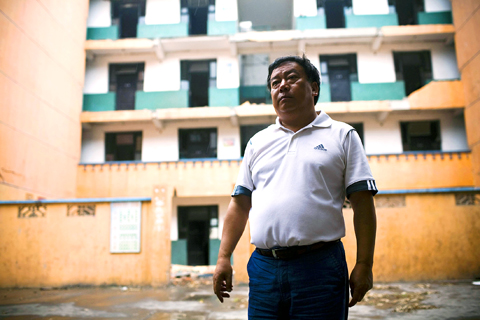In the minutes after the May 12 earthquake, the students lined up row by row on the outdoor basketball courts of Sangzao Middle School. When the head count was complete, their fate was clear: All 2,323 were alive.
Parents covered in blood and dust hugged them and cried. So did the school principal, Ye Zhiping.
“That was the single most joyful thing,” he said.

PHOTO: NY TIMES NEW SERVICE
Given that some 10,000 other children were crushed in their classrooms during the devastating quake, the survival of so many students in Sangzao counts as a minor miracle. Students and parents credit that to the man they call “Angel Ye.”
Nervous about the shoddiness of the buildings, Ye scraped together US$60,000 to renovate it in the 1990s. He had workers widen concrete pillars and insert iron rods into them. He demanded stronger balcony railings. A bathroom whose pipes had been weakened was demolished.
His school in Peace County was very likely to have withstood the 8-magnitude earthquake because he pushed the county government to upgrade it. Just 32km north, the collapse of Beichuan Middle School buried 1,000 students and teachers.
Ye’s tale sheds light on the lax building codes in this mountainous corner of Sichuan Province and what might have been done to address well-known shortcomings. In his case, a personal commitment and a relatively petty amount of cash sufficed to avert tragedy.
“We learned a lesson from this earthquake: The standards for schools should have been improved,” Ye, 55, said in a recent interview. “The standards now are still not enough.”
PREPAREDNESS
Ye not only shored up the building’s structure, but also had students and teachers prepare for a disaster. They rehearsed an emergency evacuation plan twice a year. Because of that, students and teachers say, everyone managed to flee in less than two minutes on May 12.
“We’re very thankful,” said Qiu Yanfang, 62, the grandmother of a student, as she sat outside the school knitting a brown sweater. “The principal helped ease the nation’s loss, both the psychological loss and the physical loss.”
Sangzao is a farming town of 30,000 where merchants sell vegetables from blankets on a rutted market road. It has two middle schools, one administered by the township, where a dormitory collapsed during the earthquake, and the other administered by the county. Ye works in the second, where families from across northern Sichuan send their children because of the school’s reputation.
A large billboard on the school grounds lists the names of 90 students who earned top scores on a national exam last year.
SHODDY CONSTRUCTION
The school is one of the largest in Peace County. It has a half-dozen dormitory buildings and two classroom buildings, all five stories or lower. One of the classroom buildings was constructed after 2000, the other between 1983 and 1985.
The older one worried Ye when he became principal 12 years ago.
It is a four-story white building with large, tinted-glass windows and blue, metal railings running along balconies onto which classrooms open.
“Quality inspectors were supposed to be here to oversee construction of this building,” he said. “When the foundation was laid, they should have been here. When the concrete was put into the pillars, they should have been here. But they weren’t.”
“In the end, no government official dared to come inspect this building because it was built without any standards,” he said.
Ye walked down the hallways with a visitor and pointed to the corners where ceiling met wall. He said workers had stuffed canvas bags and trash into those crevices to seal them. In addition, he said, the surfaces of the walls were coarse rather than smooth, a sign of shoddy construction.
The balcony railings were originally made of cement, not metal. They were shaky and too short, Ye said. They also lacked vertical pillars for support.
“I was among the first teachers who moved into this building, and I was pretty young,” Ye said. “Our awareness of safety wasn’t the same as now.”
TIME TO ACT
He said his attitude changed after he became principal.
“If I knew there was a hidden danger, and I didn’t do anything about it, then I would be the one responsible,” he said.
From 1996 to 1999, Ye oversaw a complete overhaul.
He said that he pestered county officials for money. Eventually the education department gave a total of US$58,000. It was a troublesome process because the county was poor and thus tight with money, Ye said, but officials saw the need to ensure the safety of children.
These days, students dart in and out of the school to grab textbooks, ducking beneath a thin blue ribbon with a handwritten sign that says “Danger.” To them, the building seems sturdy enough.
But Ye said it will be torn down, never again used for classes.

POLITICAL PRISONERS VS DEPORTEES: Venezuela’s prosecutor’s office slammed the call by El Salvador’s leader, accusing him of crimes against humanity Salvadoran President Nayib Bukele on Sunday proposed carrying out a prisoner swap with Venezuela, suggesting he would exchange Venezuelan deportees from the US his government has kept imprisoned for what he called “political prisoners” in Venezuela. In a post on X, directed at Venezuelan President Nicolas Maduro, Bukele listed off a number of family members of high-level opposition figures in Venezuela, journalists and activists detained during the South American government’s electoral crackdown last year. “The only reason they are imprisoned is for having opposed you and your electoral fraud,” he wrote to Maduro. “However, I want to propose a humanitarian agreement that

ECONOMIC WORRIES: The ruling PAP faces voters amid concerns that the city-state faces the possibility of a recession and job losses amid Washington’s tariffs Singapore yesterday finalized contestants for its general election on Saturday next week, with the ruling People’s Action Party (PAP) fielding 32 new candidates in the biggest refresh of the party that has ruled the city-state since independence in 1965. The move follows a pledge by Singaporean Prime Minister Lawrence Wong (黃循財), who took office last year and assumed the PAP leadership, to “bring in new blood, new ideas and new energy” to steer the country of 6 million people. His latest shake-up beats that of predecessors Lee Hsien Loong (李顯龍) and Goh Chok Tong (吳作棟), who replaced 24 and 11 politicians respectively

Young women standing idly around a park in Tokyo’s west suggest that a giant statue of Godzilla is not the only attraction for a record number of foreign tourists. Their faces lit by the cold glow of their phones, the women lining Okubo Park are evidence that sex tourism has developed as a dark flipside to the bustling Kabukicho nightlife district. Increasing numbers of foreign men are flocking to the area after seeing videos on social media. One of the women said that the area near Kabukicho, where Godzilla rumbles and belches smoke atop a cinema, has become a “real

‘WATER WARFARE’: A Pakistani official called India’s suspension of a 65-year-old treaty on the sharing of waters from the Indus River ‘a cowardly, illegal move’ Pakistan yesterday canceled visas for Indian nationals, closed its airspace for all Indian-owned or operated airlines, and suspended all trade with India, including to and from any third country. The retaliatory measures follow India’s decision to suspend visas for Pakistani nationals in the aftermath of a deadly attack by shooters in Kashmir that killed 26 people, mostly tourists. The rare attack on civilians shocked and outraged India and prompted calls for action against their country’s archenemy, Pakistan. New Delhi did not publicly produce evidence connecting the attack to its neighbor, but said it had “cross-border” links to Pakistan. Pakistan denied any connection to